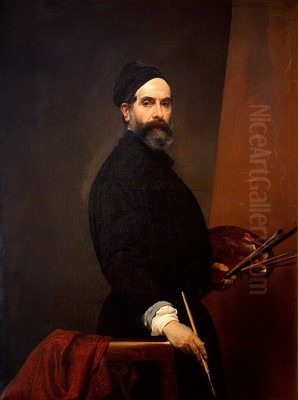
Francesco Hayez stands as a monumental figure in the landscape of nineteenth-century Italian art. His life and career spanned a period of profound political and cultural transformation in Italy, and his work not only reflected these changes but also actively contributed to shaping the nascent national identity. As a leading exponent of Romanticism, Hayez masterfully blended historical grandeur with intimate emotion, creating a visual language that resonated deeply with his contemporaries and continues to captivate audiences today. His journey from a young, aspiring artist in Venice to the revered master of Milan is a testament to his talent, adaptability, and profound understanding of the artistic and social currents of his time.
Early Life and Artistic Awakening in Venice
Francesco Hayez was born in Venice on February 10, 1791, into a family of modest means. His father, Giovanni Hayez, was of French origin, while his mother, Chiara Torcella, hailed from Murano, an island famous for its glassmaking. Francesco was the youngest of five sons. Due to the family's financial constraints, he was entrusted to the care of his maternal aunt and her husband, Giovanni Binasco. Binasco, a shipowner and a keen art collector, recognized young Francesco's burgeoning talent for drawing and became his first significant patron.
Binasco initially placed Hayez with an art restorer, where the boy could learn the rudiments of art. Subsequently, he arranged for Hayez to study under the tutelage of Francesco Maggiotto, a respected Venetian painter. Under Maggiotto, Hayez honed his skills, absorbing the rich artistic traditions of Venice, a city that had nurtured masters like Titian, Veronese, and Tintoretto. He furthered his formal education at the New Academy of Fine Arts in Venice, founded in 1807, where he studied under Teodoro Matteini. Even in these early years, Hayez demonstrated a remarkable aptitude, winning a competition in 1809 that secured him a coveted scholarship to the prestigious Accademia di San Luca in Rome.
The Roman Crucible and Neoclassical Foundations
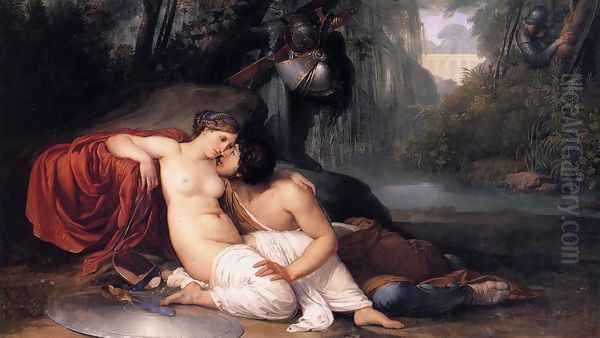
The move to Rome in 1809 marked a pivotal phase in Hayez's development. Rome, at that time, was the epicenter of Neoclassicism, an artistic movement that sought inspiration from the art and culture of ancient Greece and Rome, emphasizing order, clarity, and idealized forms. Here, Hayez came under the profound influence of Antonio Canova, the leading Neoclassical sculptor of the era and a dominant figure in the Roman art world. Canova, also of Venetian origin, took the young Hayez under his wing, offering guidance, support, and friendship.
During his Roman sojourn, Hayez immersed himself in the study of classical antiquities and the works of Renaissance masters like Raphael. He diligently copied from the antique and participated in academic competitions. His painting Laocoön (1812) won him a prize from the Accademia di San Luca, further solidifying his reputation. Another significant early work from this period is Rinaldo and Armida (1812-1813), which, while demonstrating Neoclassical clarity in composition, also hints at the burgeoning Romantic sensibility in its dramatic subject matter drawn from Torquato Tasso's epic poem "Jerusalem Delivered." He also painted Ulysses at the Court of Alcinous (1813-1815), commissioned by Joachim Murat, then King of Naples. This period was crucial for Hayez in mastering the technical aspects of painting and understanding the prevailing artistic doctrines, even as his own inclinations began to steer him towards a more emotionally charged form of expression. Other prominent Neoclassical artists of the time, whose influence permeated the artistic atmosphere, included the French painters Jacques-Louis David and Jean-Auguste-Dominique Ingres, though Hayez's path would diverge significantly from theirs.
The Shift to Milan and the Embrace of Romanticism
After a period in Naples, where he worked on frescoes for Joachim Murat, Hayez eventually settled in Milan around 1820. Milan was rapidly becoming a vibrant cultural and intellectual hub, and it was here that Hayez's career truly blossomed, and he became the undisputed leader of the Romantic movement in Italian painting. Italian Romanticism, while sharing some characteristics with its counterparts in France (led by artists like Eugène Delacroix and Théodore Géricault) and Germany (with figures such as Caspar David Friedrich), had its own distinct flavor, often intertwined with the patriotic sentiments of the Risorgimento, the movement for Italian unification.
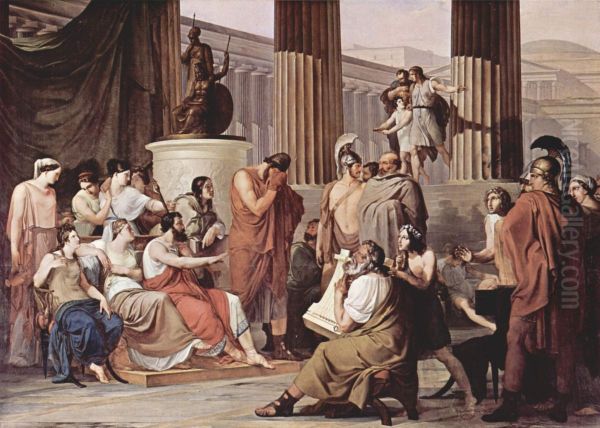
In Milan, Hayez found a receptive environment for his evolving artistic vision. He became a professor of painting at the Accademia di Belle Arti di Brera in 1850, a position he held for many years, influencing a generation of artists. His style began to shed the stricter constraints of Neoclassicism, embracing more dynamic compositions, richer color palettes, and a greater emphasis on emotional intensity and narrative drama. He drew inspiration from medieval and Renaissance history, literature (particularly Shakespeare, Byron, and Walter Scott), and contemporary events, often imbuing his subjects with allegorical or patriotic meaning.
Historical Narratives and Patriotic Allegories
Hayez excelled in the genre of historical painting, which became a powerful vehicle for expressing the ideals of Romanticism and the aspirations of the Italian people. His works in this vein were not mere depictions of past events but were often charged with contemporary relevance, subtly alluding to the struggle for independence and unity.
One of his earliest Milanese triumphs was Pietro Rossi, Lord of Parma, Stripped of His Dominions (1818-1820). This painting, depicting a 14th-century nobleman being urged by his wife and daughters to refuse a Venetian offer that would mean abandoning his besieged city, was lauded for its dramatic intensity and its implicit message of loyalty and sacrifice for one's homeland. The emotional turmoil of the figures, rendered with psychological acuity, marked a clear departure from Neoclassical stoicism.
Perhaps Hayez's most iconic work, and a symbol of Italian Romanticism itself, is The Kiss (Il Bacio), painted in 1859. The painting depicts a medieval couple locked in a passionate embrace, the man poised as if to depart for a dangerous mission. While overtly a scene of romantic love, it was widely interpreted as an allegory for the political union of Italy and France against Austria, or more broadly, as a symbol of youthful patriotism and the sacrifices made for national liberation. The rich colors, the dramatic lighting, and the palpable emotion of the scene made it an instant success. Hayez painted several versions of The Kiss, subtly altering details and colors, which some scholars suggest correspond to the changing political alliances of the Risorgimento.
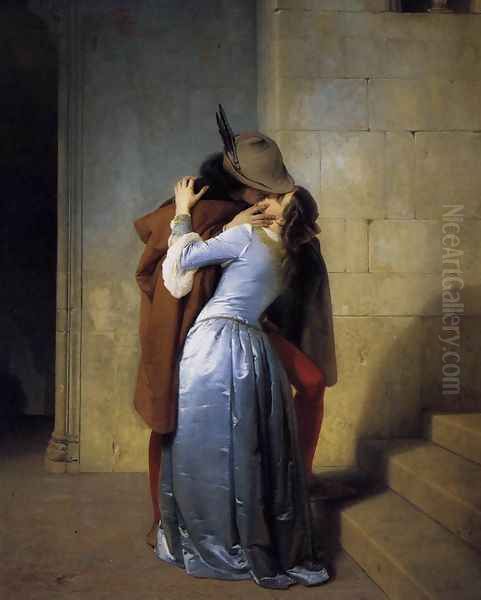
Another significant historical painting is The Sicilian Vespers (I Vespri Siciliani), completed in various versions between 1821 and 1846. This work depicts the 13th-century rebellion of Sicilians against French rule, a theme that resonated strongly with contemporary Italian desires to oust foreign occupiers. The painting is a complex, multi-figure composition, showcasing Hayez's skill in orchestrating dramatic narratives and conveying a wide range of human emotions, from outrage to determination. These historical paintings, with their blend of meticulous historical detail and heightened emotional drama, set Hayez apart and cemented his reputation. He shared this interest in historical subjects with other European Romantics, such as Paul Delaroche in France.
The Art of Portraiture: Capturing the Spirit of an Age
Beyond his grand historical compositions, Francesco Hayez was also a highly sought-after portrait painter. His portraits are characterized by their psychological depth, their elegant yet unpretentious rendering of the sitters, and their ability to capture the essence of the individual within their social context. He painted many of the leading figures of his time, including intellectuals, artists, aristocrats, and patriots.
Among his most notable portraits is that of the writer Alessandro Manzoni, author of the seminal Italian novel "I Promessi Sposi" (The Betrothed). Hayez's portrait of Manzoni (1841) presents the author with a thoughtful, introspective air, conveying his intellectual stature and moral authority. He also painted portraits of the composer Gioachino Rossini, the statesman Count Camillo Benso di Cavour (a key architect of Italian unification), and the poet and playwright Andrea Maffei, who was a close friend. His portrait of Clara Maffei, a prominent salonnière whose gatherings were frequented by artists and intellectuals, captures her intelligence and charm.
Hayez's approach to portraiture was less about overt flattery and more about revealing character. He employed a refined technique, with careful attention to detail in costume and setting, but always ensuring that the sitter's personality remained the focal point. His female portraits, in particular, often possess a subtle sensuality and an air of romantic melancholy, reflecting the prevailing aesthetic sensibilities of the era. His skill in this genre rivaled that of other great nineteenth-century portraitists like Franz Xaver Winterhalter, though Hayez's style was generally more subdued and introspective.
Sensuality, the Female Form, and Orientalist Themes
A significant aspect of Hayez's oeuvre is his depiction of the female form, often in mythological, biblical, or Orientalist contexts. These works showcase his mastery of rendering human anatomy and his ability to imbue his figures with a palpable sensuality that, while sometimes controversial, was also highly admired.
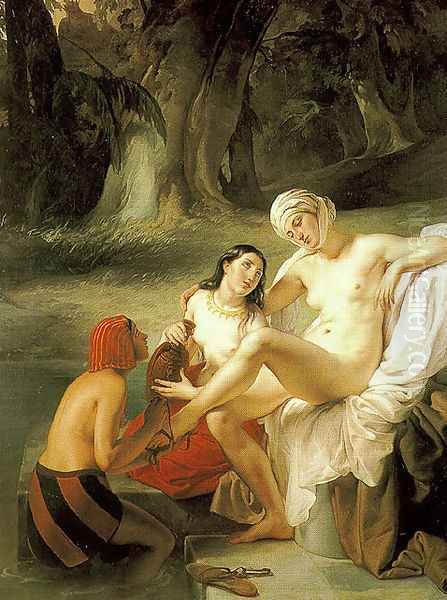
Works such as Bathsheba at her Bath (various versions) and The Penitent Magdalene (1825) highlight his skill in portraying nude or semi-nude figures with a blend of classical idealization and romantic allure. His Odalisque paintings, reflecting the nineteenth-century European fascination with the "Orient," depict reclining female figures in exotic settings, often characterized by rich textiles and a languid, sensual atmosphere. These works align with the broader Orientalist trend in European art, seen in the works of artists like Ingres (e.g., La Grande Odalisque) and Delacroix (e.g., Women of Algiers in their Apartment).
Hayez's female figures are rarely passive objects of gaze; they often possess a psychological complexity and an emotional depth that invites contemplation. While some of his works, particularly those with more overt sensuality, did provoke discussion in their time, they were generally seen within the accepted conventions of academic art that allowed for the depiction of the nude in historical, mythological, or allegorical contexts. The provided information mentions works like Tamar and Judah (1845) and The Bathers (1850), which would fit into his exploration of biblical themes and the idealized human form in natural settings. The claim of him creating works titled Cunnilingus or Mutual Masturbation as part of a "sex guide" is highly uncharacteristic of Hayez's public oeuvre and reputation and likely refers to misattributed or extremely private, unverified sketches, if they exist at all. His public works, while sensual, operated within the bounds of established artistic genres.
Teaching, Influence, and Artistic Circle
As a long-standing professor at the Brera Academy, Francesco Hayez exerted a considerable influence on the succeeding generation of Italian artists. His studio was a hub of artistic activity, and his guidance shaped many young talents. Among his students were figures such as Carlo Belgioioso, Amanzio Cattaneo, Angelo Pietrasanta, Cherubino Cornenti, Francesco Valaperta, Ismael Telega Milla, Carlo Antonio Vella, Livo Pecora, Antonio Silo, and Francesco Aforeddo. Through them, his artistic principles and his Romantic vision were disseminated further.
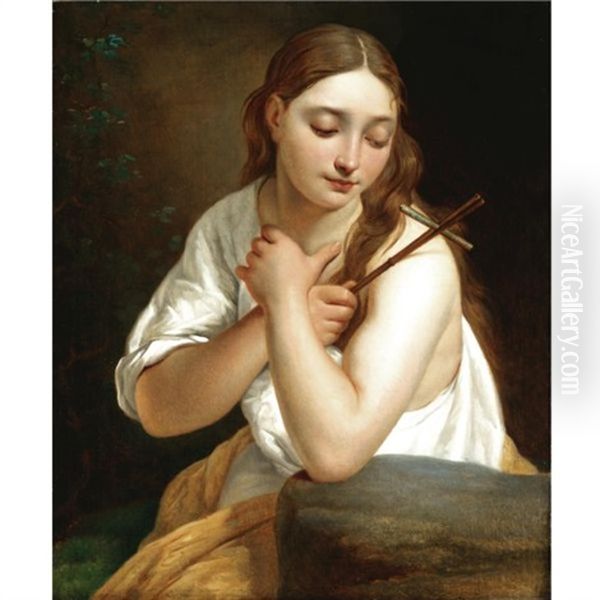
Hayez was also an active participant in Milan's vibrant cultural life. He was a prominent member of the "Salotto Maffei," the salon hosted by Clara Maffei, which was a meeting place for leading literary figures, musicians (like Giuseppe Verdi), and patriots. His friendships with individuals like Andrea Maffei and Alessandro Manzoni underscore his integration into the intellectual elite of his time. His interactions with fellow artists, both established figures like Pelagio Palagi, who also worked in Milan, and younger painters, helped to foster a dynamic artistic environment. While Hayez was a dominant figure, other artistic currents also existed in Italy, such as the Purismo movement advocated by artists like Tommaso Minardi, which sought a return to the simplicity and piety of early Renaissance art, offering a different path from Hayez's more dramatic Romanticism.
A peculiar aspect of Hayez's professional practice was his tendency not to sign or date many of his works. This has occasionally complicated art historical scholarship, with dating often relying on records of acquisition, exhibition, or stylistic analysis. This practice might reflect a certain modesty or perhaps a belief that the work should speak for itself, but it remains an intriguing characteristic of his career.
Later Years and Enduring Legacy
Francesco Hayez remained artistically active into his old age. While his later works sometimes saw a shift towards more religious themes or a revisiting of earlier subjects, his commitment to his craft never wavered. He continued to be a revered figure in the Italian art world, witnessing the unification of Italy – a cause that his art had so passionately supported.
He passed away in Milan on December 21, 1882, at the venerable age of 91. He had lived through one of the most tumultuous and transformative periods in Italian history, and his art serves as a profound chronicle of that era's emotions, aspirations, and ideals. Hayez never married and dedicated his long life almost entirely to his art.
His legacy is immense. He is widely regarded as the most important Italian painter of the nineteenth century and the foremost representative of Italian Romanticism. His ability to synthesize historical subject matter with contemporary political sentiment, classical technique with Romantic emotion, and grand narrative with intimate portraiture, marks him as a singularly versatile and impactful artist. His works, particularly The Kiss, have become enduring symbols of Italian art and national identity. Major collections of his work are housed in prestigious Italian museums, most notably the Pinacoteca di Brera in Milan and the Gallerie d'Italia, also in Milan, with other significant pieces in the Accademia Carrara in Bergamo and various public and private collections across Italy and internationally, including potentially the Liechtenstein Museum in Vienna and the National Gallery in London, though his core presence remains in Italy.
Hayez in the Context of His Contemporaries
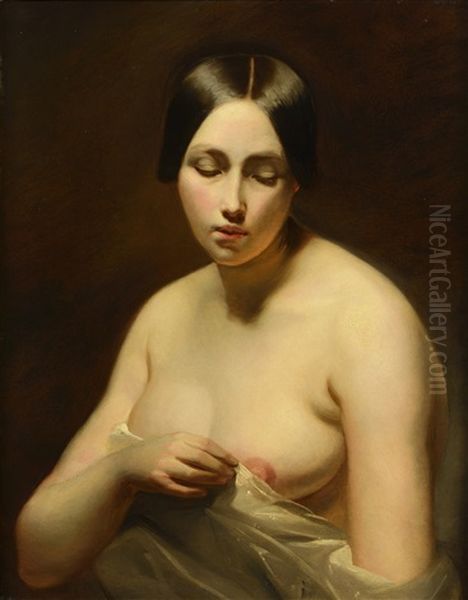
To fully appreciate Hayez's stature, it is useful to consider him alongside his international contemporaries. In France, Delacroix was the champion of Romanticism, known for his vibrant color, dynamic compositions, and exotic or revolutionary themes (e.g., Liberty Leading the People). Géricault, with works like The Raft of the Medusa, explored themes of human suffering and contemporary tragedy. While Hayez shared their passion and emotional intensity, his style often retained a greater degree of classical finish and compositional balance, perhaps reflecting his Italian artistic heritage and Canova's early influence.
In Germany, Caspar David Friedrich created evocative Romantic landscapes imbued with spiritual and symbolic meaning, a very different focus from Hayez's narrative and historical paintings. In Britain, J.M.W. Turner revolutionized landscape painting with his atmospheric and light-filled canvases, while John Constable focused on the naturalistic depiction of the English countryside. Francisco Goya in Spain, a towering figure whose career bridged the late 18th and early 19th centuries, produced deeply personal and often disturbing works that prefigured many aspects of modern art.
Within Italy itself, Hayez stood out. While artists like Giuseppe Bezzuoli in Florence also worked on historical Romantic themes, Hayez's impact in Milan and his consistent production of high-profile, politically resonant works gave him a unique prominence. He successfully navigated the transition from the waning Neoclassicism of artists like Andrea Appiani to a fully realized Romantic vision that defined Italian painting for much of the mid-nineteenth century.
Conclusion: The Enduring Power of Hayez's Vision
Francesco Hayez was more than just a technically proficient painter; he was an artist who captured the zeitgeist of his nation. His canvases tell stories of love, sacrifice, patriotism, and human drama, rendered with a skill and emotional depth that continue to speak to viewers. From the quiet intensity of his portraits to the sweeping grandeur of his historical epics, Hayez's art provides a rich and multifaceted window into the soul of nineteenth-century Italy. His ability to connect with the public on an emotional and intellectual level, particularly through works that resonated with the Risorgimento, secured his place not only in art history but also in the cultural memory of Italy. As a master storyteller, a brilliant technician, and a profound interpreter of the human condition, Francesco Hayez remains a pivotal figure, whose art continues to inspire and move.